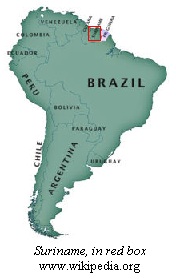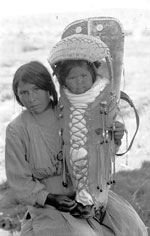Ndyuka Collection
Suriname and the Maroons
Suriname, originally a Dutch colony, has been independent since 1975. This small country, located on the northeast coast of South America, has cultural attributes more in common with Caribbean countries.

Suriname, originally a Dutch colony, has been independent since 1975. This small country, located on the northeast coast of South America, has cultural attributes more in common with Caribbean countries.
In the mid-seventeenth century, the area known today as Suriname was settled by the British from Barbados, who began shipping Africans to Suriname as slaves to work on their plantations. At the Peace of Breda in 1667, ending the Second Anglo-Dutch War, Suriname was relinquished to the Dutch, and English settlers withdrew. Dutch plantation owners followed in the footsteps of the English and continued the importation of African slaves into the nineteenth century.
There is also a reconstructed façade of a house and two black and white photographs of daily life; a stool; peanut grinding board; combs; food stirrers; and calabash spoons. The exhibit case, called "Bush Negro of Suriname South America" is located on the third floor of the Museum, at the end of the African Hall and the beginning of the South American Hall.
This collection was obtained from the Ndyuka of Suriname, a small Caribbean country on the northeast coast of South America. The Ndyuka are one of the six major Maroon groups living in either Suriname or nearby French Guiana. Maroon is a term used to denote the descendants of African runaway slaves from Dutch plantations during the late-17th and early-18th centuries. The culture is thus strongly rooted in West and Central African cultural traditions with some Amerindian influences. The collection of over 50 items, the majority donated by Peter French in 1945, relates to everyday activities, such as kitchen utensils, a laundry beater (as pictured here), and hammocks. Few museums in the United States have collections from the Ndyuka. See Ndyuka items exhibited on the Museum's Third Floor where the African and Latin American Halls converge.
For the most comprehensive introduction to Maroon societies (including several articles about the Ndyuka), see:
Richard Price (ed.), Maroon Societies: Rebel Slave Communities in the Americas (third editions, revised, with a new preface, Baltimore, Johns Hopkins University Press, 1996).
Peter French donated 51 Ndyuka artifacts to the MPM in 1945, constituting the vast majority of Suriname artifacts in the collection. These items included wooden food stirrers, combs, hammocks, calabash utensils, a baton, a laundry beater, and a white clay (pemba) sample. Unfortunately, not much is known about the life or work of this particular source.
 American Indian Cradles and Cradleboards - The Museum’s collection of cradles, cradleboards, and associated accoutrements includes nearly 200 items.
American Indian Cradles and Cradleboards - The Museum’s collection of cradles, cradleboards, and associated accoutrements includes nearly 200 items.